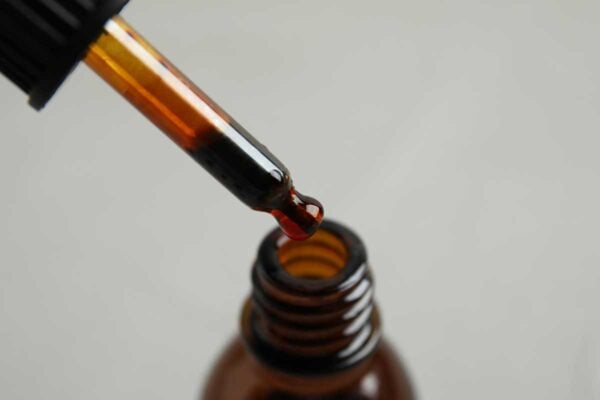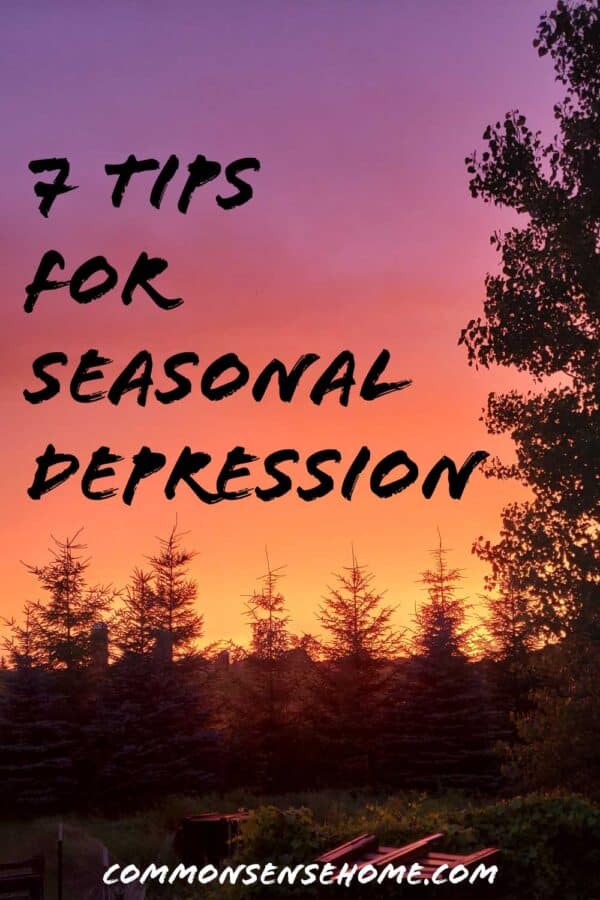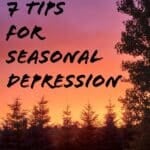7 Tips for Seasonal Depression – Beat the Winter Blues
Seasonal Affective Disorder (SAD), is commonly referred to as seasonal depression. When daylight hours shorten, it can mess with your system. I reached out to our readers for their best tips for seasonal depression, and gathered some of my own.

Whether you’re experiencing it or supporting someone who is, understanding SAD and having strategies to manage it can help.
What Is Seasonal Depression?
Seasonal depression is a form of depression triggered by seasonal changes, most commonly occurring in fall and winter. (Some people do experience depressive symptoms with other season changes.)
The exact cause isn’t fully understood, but researchers believe reduced sunlight affects serotonin and melatonin levels. This leads to changes in mood and sleep patterns. (More on this in a bit.)
Symptoms of Depression
Symptoms of SAD include:
- Fatigue despite getting enough sleep
- Difficulty concentrating
- Feelings of sadness or hopelessness
- Changes in appetite or weight
- Loss of interest in activities once enjoyed
- Social withdrawal or increased isolation
- Irritability or restlessness
- Sleep disturbances (either too much or too little)
Tips for Seasonal Depression Management
If you or someone you know experiences SAD, here are some treatment options to help alleviate symptoms:
1. Maximize Exposure to Natural Light
Natural sunlight can boost serotonin production and improve mood. Try these strategies:
- Spend time outdoors during daylight, even when it’s cloudy.
- Sit near windows to soak up as much natural light as possible.
- Take walks in the morning or during lunch breaks.
We like to take a walk after morning chores. If you can get your walk in earlier in the day, it’s better, as this is when we want higher serotonin levels. That said, any time outside is better than none at all, so work with your schedule.
If you have a sunroom or greenhouse, that’s a great option for natural light exposure to fight the winter blues. Make the space welcoming so it’s easier to spend time there. Add a comfortable chair, and/or a spot for reading or crafts.
Some communities also have enclosed arboretums or public venues with natural lighting. You can visit these and get a little sun time and human time.
2. Light Therapy
For many, light therapy can be an effective for treating SAD. A light therapy lamp mimics natural sunlight and can help regulate melatonin and serotonin levels. Typically, users sit in front of the light box for 20-30 minutes each morning. It’s essential to use the light box consistently and early in the day for the best results.
If you don’t want to hunt down a light therapy box, you can improvise with other forms of bright lights.
Marg shares:
I live on Vancouver Island where it rains a lot in the winter. My living room faces west so even in summer it doesn’t get sun until late in the day. This is great in summer but in winter it is dark.
For years now (20+) I have switched out all the light bulbs in my living room lamps to grow light bulbs (Sunblaster). They are a bit pricey to buy but they last a very long time. They are not expensive to use. I have the lights on from the time I get up until I go to bed.
3. Exercise Regularly
Exercise is a natural mood booster, releasing endorphins that combat stress and depression. Try to stay active, even when energy is low.
Opt for activities that you enjoy, such as walking, yoga, swimming, or dancing. If outdoor exercise isn’t appealing in colder months, find indoor activities or join a gym.
One surprising option that I’ve found to boost my mood and energy levels is rebounding. Rebounding is using a small trampoline to bounce for low impact aerobic exercise.
Rebounding makes it easy to get a little movement in, even when you’re tired. It’s also very gentle on your joints, which is especially helpful to those of us who get a little stiff in cold weather. Rebounding is also excellent for your lymphatic system, helping your body to clear out toxins.
4. Stick to a Routine
Winter depression can disrupt your normal routines – like sleep patterns. Sometimes modern life demands that we be at certain activities at certain times. To help keep your day on schedule, set regular sleep and wake times. If you can, get to bed a little earlier at night.
If your lifestyle allows, work with the natural daylight rhythms. Sleep a little later and go to bed a little earlier when we’re near winter solstice. Humans aren’t immune to the urge to hunker down for the cold weather season.
Plan enjoyable activities, even if you don’t feel like it at first. Having something to look forward to brightens the day.
Would you like to save this?
Eat healthy meals at consistent times, focusing on nutrient-dense foods. This helps avoid emotional eating or cravings for carbs and sugar. Hot drinks like herbal tea or mulled cider can provide comfort without a ton of calories.
5. Add Stress-Relief Practices & Mood Lifters
Mindfulness, meditation, and relaxation techniques can help you manage SAD. Mindfulness keeps you grounded in the present, reducing stress and preventing your mood from spiraling.
Practice deep breathing exercises, progressive muscle relaxation, or guided meditation. Apps like Calm or Headspace help to incorporate mindfulness into your daily routine. (I am not an app person, but I know some people love them.)
Wendy Anne says:
I used to suffer with seasonal depression until I learned to listen to my own inner rhythm, which is in tune with nature’s rhythm in the Pacific northwest where I live. Now I slow down, turn within, and let the seeds of my own inner knowing grow by doing so.
I used Michael Brown’s book, The Presence Process for years, a 10 week exploration which I started on the fall equinox. It was the most helpful on my journey at that time.
Charlene shares:
I do start feeling down when the days are so noticeably shorter. I pray and read the Bible. The older I get the harder the short days are for me. But my Lord and Savior helps me through.
One of my favorite tips for seasonal depression is to make time for things that you love and those that bring you joy. I turn on music while I’m working. There’s nothing like a favorite melody or an old familiar tune to shift your mindset.
Donna says:
It’s easy here in Alaska to become depressed in our long winters. I turn on candles first thing in the morning. (I used to do real candles but since we went through a wildfire, hubby and I both are uncomfortable with open flames.) I have the ones that look real with moving flames – I love them!
I make a pot of tea–usually chai, vanilla rooibos or honey bush. As the winter progresses I add an essential oil diffuser with uplifting scents. I add Peace & Calming essential oil or the chakra oils after my shower. I wear bright colorful clothes even if I am staying home. I add colorful lipstick. (I commonly wear lipstick, but no other makeup.) I add uplifting music.
6. Socialize and Stay Connected
Even though SAD can make socializing feel overwhelming, isolation tends to exacerbate symptoms. Stay connected with friends, family, or support groups. Arrange casual get-togethers, phone calls, or even short video chats to maintain human connection.
Book clubs are a great option (for my fellow book lovers). Cold weather and long evenings lend themselves to more reading time. One of my favorite ways to enjoy a good book is to share it with others.
Consider service work and volunteering, too. Helping others often helps us to help ourselves. I know that I feel better when I feel useful and needed.
7. Supplements for Seasonal Depression
Vitamin D supplements are a common recommendation for treating seasonal depression, but study results are mixed. I prefer natural options over pills.
Trish agrees:
I always got it (SAD) until the year my husband died. I thought there was likely no way I would make it through the winter with grief on top of SAD but I wasn’t going down without a fight so I decided to try something I read about, sitting in the sunshine for a minimum of fifteen minutes every day that the sun was out.
It was getting chilly so I sat in the sunshine in my front room with my gown pulled up and the sleeves rolled up to expose all the skin I could and set a timer on my phone to make sure I got at least the recommended dosage. Usually it was longer but also some days it was cloudy so I got all I could.
Well, the next time I had my blood tested my vitamin D level was right in the middle of the acceptable range for the first time in many years, even though I was taking supplemental D. I became a believer. Don’t listen to people say you can’t get vitamin D from the sun just so they can sell you something. I’m living proof.

Sandra use iodine for seasonal depression:
I have had a daily topical dose of iodine. The iodine is in a base of glycerin. The brand I have been using for years is TPCS Iosol II.
The topical dose is one drop per 50 lbs. of weight. I apply the drops to the inside of a wrist where my skin is thin and will absorb the dose more quickly, and rub my two wrists together. Some people will rub it onto the skin of their inner thighs or behind their knees.
It usually is absorbed within seconds. If the brown color of the iodine is still visible after 10 minutes, you may have had enough to last more than a day. I have never reached the saturation point. The glycerin may feel a little sticky for a while. Do not wash it off before the the iodine is absorbed. Wait at least 15 minutes.
When to Seek Help for Seasonal Depression
If your symptoms are severe or persist, it may be beneficial to consult a therapist or mental health professional. Cognitive-behavioral therapy (CBT) may be effective for treating seasonal depression, helping people reframe negative thoughts and develop coping strategies. Medications like antidepressants may also be prescribed in some cases.
More Self Care Tips and Tools
Our Home Remedies and health tips make it easier for you to care for yourself and those you love. Some articles include:
Best Natural Decongestants for the Whole Family
12 Home Remedies for Earaches (Safe for Children & Breastfeeding)
Best Probiotics for Cold and Flu (+ 5 Ways they Help)
Do you have a tip for seasonal depression that hasn’t been mentioned here? Share your thoughts in the comments.


This article is written by Laurie Neverman. Laurie is a lifelong learner with a passion for natural remedies and holistic healing. She’s successfully improved her eyesight and cleared her psoriasis.

